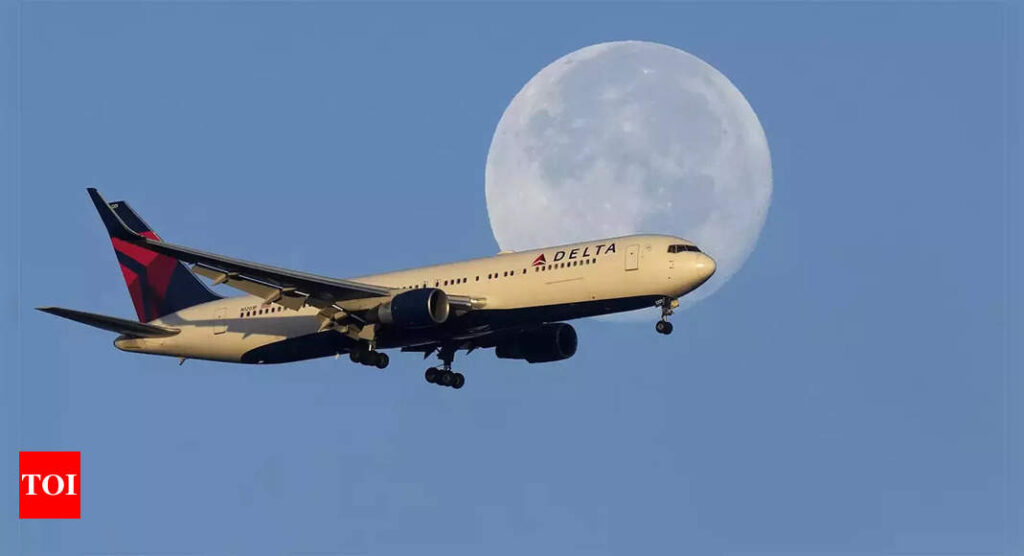[ad_1]
MUMBAI: India’s domestic air travel demand rose by about 17 % in September as compared to the same month last year, putting India at the third slot after China and Japan in terms of domestic air traffic growth, according to data shared by the International Air Transport Association (IATA) in its monthly traffic report released on Thursday.
Air travel demand measured in Revenue Passenger Kilometers (RPK) is the number of fare-paying passengers multiplied by the total distance they travelled.Total traffic (domestic and international) in September 2023 (measured in RPKs) rose 30 % compared to September 2022. “Globally, traffic is now at 97.3% of pre-COVID levels,” said the IATA report.
Though China led the domestic passenger markets growth list with a 169% rise in domestic demand year over year, there was low base effect at play as domestic travel restrictions were reintroduced in some Chinese provinces in September last year. Japan’s domestic traffic rebounded strongly from the impact of typhoons in August, as RPKs rose 19.9% compared to September 2022, said the IATA report. Domestic passenger load factor for September was 84.7 % for India and Australia, which was the highest in the world. While China and Japan had a domestic passenger load factor of about 77% and 79% respectively.
“The third quarter of 2023 ended on a high note, with record domestic passenger demand for the month of September and continued strong international traffic,” said Willie Walsh, IATA’s Director General. Domestic traffic hit a new high for the month of September, as traffic rose 28 % versus September 2022 and exceeded the September 2019 level by 5.0%. International traffic climbed 31 % compared to the same month a year ago. “All markets saw double-digit percentage gains year on year. International RPKs reached 93 % of September 2019 levels,” said IATA.
Asia-Pacific airlines had a 92.6% increase in September 2023 traffic compared to September 2022, thanks largely to China. They continued to lead the regions in terms of annual improvement. Capacity climbed 82.1% and the load factor increased by 4.5 percentage points to 82.5%. European carriers’ September traffic climbed 15.7% versus September 2022. Capacity increased 14.9%, and load factor edged up 0.6 percentage points to 85.5%. Middle Eastern airlines saw a 26.6% increase in September traffic compared to a year ago. Capacity rose 23.7% and load factor climbed 1.9 percentage points to 81.8%, the report said. North American carriers had an 18.9% traffic rise in September 2023 versus the 2022 period. Capacity increased 18.0%, and load factor improved 0.6 percentage points to 85.6%. Latin American airlines’ traffic rose 26.8% compared to the same month in 2022. September capacity climbed 24.7% and load factor rose 1.4 percentage points to 85.8%. African airlines posted a 28.1% traffic increase in September 2023 versus a year ago. Capacity was up 29.9% and load factor slipped 1.0 percentage points to 72.6%.
Air travel demand measured in Revenue Passenger Kilometers (RPK) is the number of fare-paying passengers multiplied by the total distance they travelled.Total traffic (domestic and international) in September 2023 (measured in RPKs) rose 30 % compared to September 2022. “Globally, traffic is now at 97.3% of pre-COVID levels,” said the IATA report.
Though China led the domestic passenger markets growth list with a 169% rise in domestic demand year over year, there was low base effect at play as domestic travel restrictions were reintroduced in some Chinese provinces in September last year. Japan’s domestic traffic rebounded strongly from the impact of typhoons in August, as RPKs rose 19.9% compared to September 2022, said the IATA report. Domestic passenger load factor for September was 84.7 % for India and Australia, which was the highest in the world. While China and Japan had a domestic passenger load factor of about 77% and 79% respectively.
“The third quarter of 2023 ended on a high note, with record domestic passenger demand for the month of September and continued strong international traffic,” said Willie Walsh, IATA’s Director General. Domestic traffic hit a new high for the month of September, as traffic rose 28 % versus September 2022 and exceeded the September 2019 level by 5.0%. International traffic climbed 31 % compared to the same month a year ago. “All markets saw double-digit percentage gains year on year. International RPKs reached 93 % of September 2019 levels,” said IATA.
Asia-Pacific airlines had a 92.6% increase in September 2023 traffic compared to September 2022, thanks largely to China. They continued to lead the regions in terms of annual improvement. Capacity climbed 82.1% and the load factor increased by 4.5 percentage points to 82.5%. European carriers’ September traffic climbed 15.7% versus September 2022. Capacity increased 14.9%, and load factor edged up 0.6 percentage points to 85.5%. Middle Eastern airlines saw a 26.6% increase in September traffic compared to a year ago. Capacity rose 23.7% and load factor climbed 1.9 percentage points to 81.8%, the report said. North American carriers had an 18.9% traffic rise in September 2023 versus the 2022 period. Capacity increased 18.0%, and load factor improved 0.6 percentage points to 85.6%. Latin American airlines’ traffic rose 26.8% compared to the same month in 2022. September capacity climbed 24.7% and load factor rose 1.4 percentage points to 85.8%. African airlines posted a 28.1% traffic increase in September 2023 versus a year ago. Capacity was up 29.9% and load factor slipped 1.0 percentage points to 72.6%.
[ad_2]
Source link











More Stories
Congress replaces Kamal Nath, names an OBC as Madhya Pradesh chief | India News
Fire breaks out in ITBP camp in Srinagar; none hurt | India News
Parliament Security: Co-villagers give clean chit to Lalit Jha, parents to move court | India News